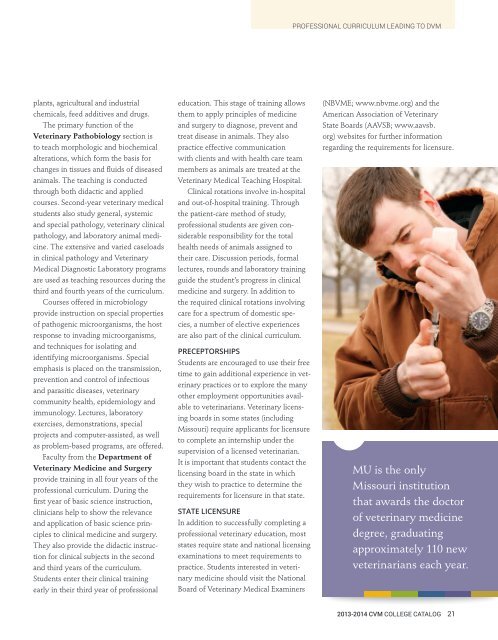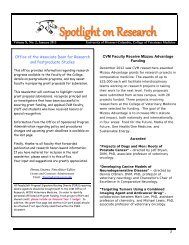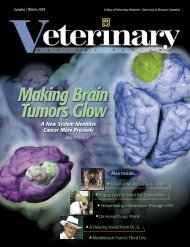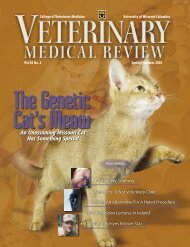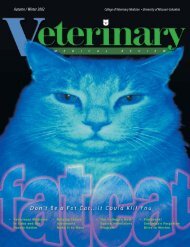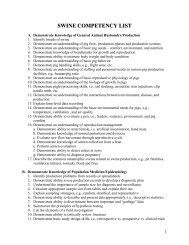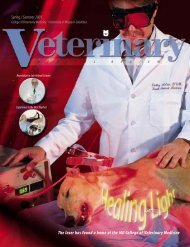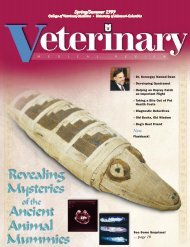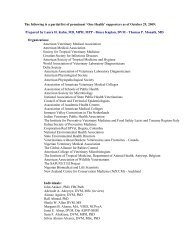2013/2014 Course Catalog - University of Missouri - College of ...
2013/2014 Course Catalog - University of Missouri - College of ...
2013/2014 Course Catalog - University of Missouri - College of ...
You also want an ePaper? Increase the reach of your titles
YUMPU automatically turns print PDFs into web optimized ePapers that Google loves.
PROFESSIONAL CURRICULUM LEADINg to DVMplants, agricultural and industrialchemicals, feed additives and drugs.The primary function <strong>of</strong> theVeterinary Pathobiology section isto teach morphologic and biochemicalalterations, which form the basis forchanges in tissues and fluids <strong>of</strong> diseasedanimals. The teaching is conductedthrough both didactic and appliedcourses. Second-year veterinary medicalstudents also study general, systemicand special pathology, veterinary clinicalpathology, and laboratory animal medicine.The extensive and varied caseloadsin clinical pathology and VeterinaryMedical Diagnostic Laboratory programsare used as teaching resources during thethird and fourth years <strong>of</strong> the curriculum.<strong>Course</strong>s <strong>of</strong>fered in microbiologyprovide instruction on special properties<strong>of</strong> pathogenic microorganisms, the hostresponse to invading microorganisms,and techniques for isolating andidentifying microorganisms. Specialemphasis is placed on the transmission,prevention and control <strong>of</strong> infectiousand parasitic diseases, veterinarycommunity health, epidemiology andimmunology. Lectures, laboratoryexercises, demonstrations, specialprojects and computer-assisted, as wellas problem-based programs, are <strong>of</strong>fered.Faculty from the Department <strong>of</strong>Veterinary Medicine and Surgeryprovide training in all four years <strong>of</strong> thepr<strong>of</strong>essional curriculum. During thefirst year <strong>of</strong> basic science instruction,clinicians help to show the relevanceand application <strong>of</strong> basic science principlesto clinical medicine and surgery.They also provide the didactic instructionfor clinical subjects in the secondand third years <strong>of</strong> the curriculum.Students enter their clinical trainingearly in their third year <strong>of</strong> pr<strong>of</strong>essionaleducation. This stage <strong>of</strong> training allowsthem to apply principles <strong>of</strong> medicineand surgery to diagnose, prevent andtreat disease in animals. They alsopractice effective communicationwith clients and with health care teammembers as animals are treated at theVeterinary Medical Teaching Hospital.Clinical rotations involve in-hospitaland out-<strong>of</strong>-hospital training. Throughthe patient-care method <strong>of</strong> study,pr<strong>of</strong>essional students are given considerableresponsibility for the totalhealth needs <strong>of</strong> animals assigned totheir care. Discussion periods, formallectures, rounds and laboratory trainingguide the student’s progress in clinicalmedicine and surgery. In addition tothe required clinical rotations involvingcare for a spectrum <strong>of</strong> domestic species,a number <strong>of</strong> elective experiencesare also part <strong>of</strong> the clinical curriculum.PreceptorshipsStudents are encouraged to use their freetime to gain additional experience in veterinarypractices or to explore the manyother employment opportunities availableto veterinarians. Veterinary licensingboards in some states (including<strong>Missouri</strong>) require applicants for licensureto complete an internship under thesupervision <strong>of</strong> a licensed veterinarian.It is important that students contact thelicensing board in the state in whichthey wish to practice to determine therequirements for licensure in that state.State LicensureIn addition to successfully completing apr<strong>of</strong>essional veterinary education, moststates require state and national licensingexaminations to meet requirements topractice. Students interested in veterinarymedicine should visit the NationalBoard <strong>of</strong> Veterinary Medical Examiners(NBVME; www.nbvme.org) and theAmerican Association <strong>of</strong> VeterinaryState Boards (AAVSB; www.aavsb.org) websites for further informationregarding the requirements for licensure.MU is the only<strong>Missouri</strong> institutionthat awards the doctor<strong>of</strong> veterinary medicinedegree, graduatingapproximately 110 newveterinarians each year.<strong>2013</strong>-<strong>2014</strong> CVM COLLEGE CATALOG 21


